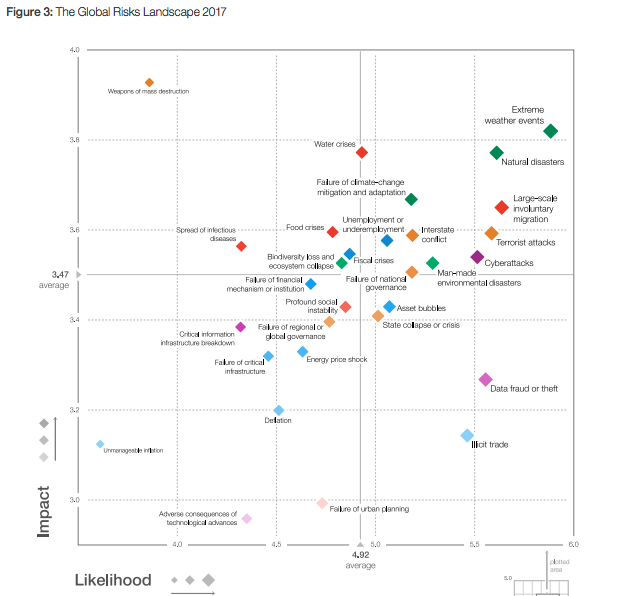New year, new forecasts. A January ritual, the issuing of lists of top risks and predictions for the year ahead, is well under way. These lists make it harder to say “Nobody saw it coming.” Or at least they ought to. Never underestimate humans’ ability to turn our attention away from what’s right in front of us.
The global, cross-sector scope of the World Economic Forum’s Global Risks Report, combined with its assessments of both impact and likelihood, make it the gold standard. The top right hand quadrant –highly likely, high impact– is where gray rhinos lurk. I particularly like the report’s feature analyzing the connections among risks. If you’ve read the Diagnosing chapter of THE GRAY RHINO, you’ll recall that looking a the connections between risks is important to deciding your strategies for dealing with them. This year’s top risks, issued this morning (hot off the pixels!), are summarized in the graph above. The report also identifies five trends that shape global risk developments: 1) Rising Income and wealth disparity, 2) Changing climate, 3) Increasing polarization of societies, 4) Rising cyber dependency, and 5) Ageing population. Read the full report HERE.
Eurasia Group’s top risks list have become more philosophical in their depictions of the dangers we face. This year’s Top Risks focus on what Ian Bremmer calls a “geopolitical recession.” As the Eurasia Group team writes: “The triumph of ‘America first’ as the primary driver of foreign policy in the world’s only superpower marks a break with decades of US exceptionalism and belief in the indispensability of US leadership, however flawed and uneven.” Hence Eurasia Group’s top risk, described as America First. The firm’s second top risk is China Overreacts, a dangerous prospect in light of China’s upcoming leadership transition, renewed concerns about the renminbi and Donald Trump’s rhetoric and overtures toward Taiwan. Third is A Weaker Merkel. In many ways, German Chancellor Angela Merkel has embodied what America used to: acting as a moral compass in face of discord. But her political future is being put to the test by the refugee crisis, a slew of corporate scandals (including ongoing, systemically dangerous problems at Deutsche Bank), the rise of populism and Euro-skepticism. Read the rest of Eurasia Group’s top risks HERE.
The Council on Foreign Relations’ Preventive Priorities Survey is focused primarily on traditional conflict. Like the World Economic Forum, it looks at both likelihood and impact. Interestingly, there was no scenario deemed both highly likely and high impact this year. Respondents’ top high-impact, moderately likely worries include a Russia-NATO conflict, a North Korea crisis, a cyber-attack in the United States, and a mass casualty terrorist attack on US territory. Moderate-impact, highly likely risks include Afghanistan, Turkish-Kurdish conflict, and Syria. Read the Preventive Priorities Survey results HERE.
Byron Wien’s Top Surprises, one of my favorite annual lists, is featured in THE GRAY RHINO. While not technically a “top risks” list, the surprises compiled by the Vice Chairman of Multi-Asset Investing at Blackstone provides a valuable road map to what might happen. Wien’s approach is very much aligned with gray rhino thinking: he looks at prevailing views and asks himself what the crowd is overlooking. He’s deeply pessimistic about Europe, predicting that Merkel will lose her re-election bid and that by the end of the year, plans are actively discussed to end the European Union and abandon the euro. On China-US relations, however, he’s considerably more optimistic than Eurasia Group. Read the top surprises, and Wien’s grading of his 2016 performance, HERE.
I’ll be monitoring the rest of the Top Risks lists issued in coming weeks. When they hit critical mass, I’ll sort through them all (similar to what Five Thirty Eight does with polls) to come up with my Top Gray Rhinos and keep tabs on those risks throughout the year -not just on how they evolve, but on how well key stakeholders are responding to them. Stay tuned…
- The Gray Rhino Wrangler on Substack - January 1, 2025
- Gray Rhino Risks and Responses to Watch in 2024 - January 10, 2024
- In the Media 2023 - December 31, 2023


